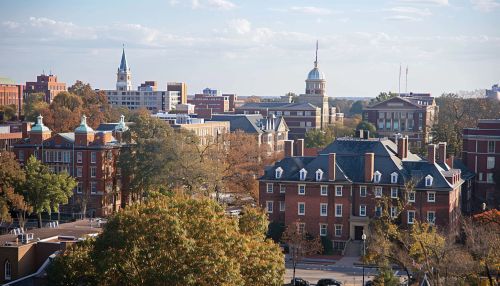Johns Hopkins University
History
Johns Hopkins University (JHU) is a private research university in Baltimore, Maryland. Founded in 1876, the university was named after its first benefactor, the American entrepreneur, abolitionist, and philanthropist Johns Hopkins. His $7 million bequest—of which half financed the establishment of the Johns Hopkins Hospital—was the largest philanthropic gift in the history of the United States up to that time.


Academics
Johns Hopkins is organized into 10 divisions on campuses in Maryland and Washington, D.C., with international centers in Italy, China, and Singapore. The two undergraduate divisions, the Zanvyl Krieger School of Arts and Sciences and the Whiting School of Engineering, are located on the Homewood campus in Baltimore's Charles Village neighborhood.
The university is also home to the Peabody Institute, a leading professional school of music located in Mount Vernon. Johns Hopkins has a strong emphasis on research, being one of the top universities in the United States in terms of research spending. The university has made significant contributions to various fields, including medicine, public health, and the natural sciences.
Research
Johns Hopkins is perhaps best known for its School of Medicine. In keeping with the university's founding principle of improving health through knowledge, the Johns Hopkins School of Medicine has been a leader in medical research and education since its founding in 1893. The school is consistently ranked among the top medical schools in the United States and has produced many notable alumni in the field of medicine.
The university also has a strong focus on public health research through the Johns Hopkins Bloomberg School of Public Health. This school is considered one of the leading institutions in the field of public health and is known for its work in epidemiology, global health, health policy, and other areas.
In addition to medicine and public health, Johns Hopkins conducts high-level research in many other fields. The Applied Physics Laboratory (APL), located in Laurel, Maryland, is one of the largest defense contractors in the United States and has made significant contributions to space exploration and national defense.
Campus
The main campus of Johns Hopkins, known as the Homewood Campus, is located in the Charles Village neighborhood of Baltimore. This campus houses the undergraduate schools of Arts and Sciences and Engineering, as well as several graduate programs. The campus is noted for its beautiful architecture and green spaces.
Other campuses include the Medical Campus in East Baltimore, which houses the School of Medicine, the School of Nursing, and the Bloomberg School of Public Health. The Peabody Campus, located in the Mount Vernon neighborhood of Baltimore, is home to the Peabody Institute, a leading professional school of music.
Notable alumni and faculty
Johns Hopkins has produced many notable alumni and faculty members, including 39 Nobel laureates. Alumni include former U.S. President Woodrow Wilson, who received his PhD from Johns Hopkins in 1886, and former Secretary of State Madeleine Albright, who received her MA from the School of Advanced International Studies.
Among the faculty, four have been awarded the Nobel Prize in Physiology or Medicine: Daniel Nathans, Hamilton O. Smith, Richard J. Roberts, and Carol W. Greider.
